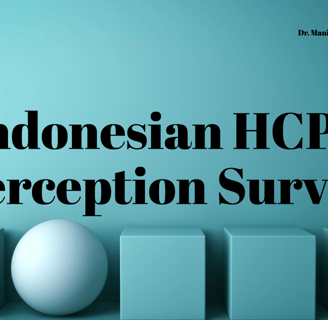HCP Perception Survey on Urological Diseases in Indonesia
The recent HCP Perception Survey on Urological Diseases in Indonesia sheds light on the prevalent medical conditions faced by healthcare professionals (HCPs) in the field of urology.
HEALTHCARE
Dr. Manish Shrivastava
10/14/20242 min read


The recent HCP Perception Survey on Urological Diseases in Indonesia sheds light on the prevalent medical conditions faced by healthcare professionals (HCPs) in the field of urology. Conducted among 1,000 urologists and physicians, this survey aims to analyze prescription patterns and gain insights into the management of urological diseases. Based on the results, here is a overview of the prevalence of various urological conditions and prescription trends observed among healthcare professionals (HCPs) in Indonesia:
1.Benign Prostatic Hyperplasia (BPH):
BPH is one of the most prevalent urological conditions, particularly among older men. It can significantly impact quality of life due to urinary symptoms.
2. Urinary Tract Infections (UTIs):
UTIs are highly common in Indonesia, with studies indicating that they frequently affect women more than men. The prevalence of UTIs is significant, contributing to numerous outpatient visits and healthcare costs[5].
3. Kidney Stones (Urolithiasis):
Kidney stones are also prevalent, with a notable incidence reported among adults. They are often associated with dietary factors and dehydration[5][6].
4. Urological Cancers:
Prostate cancer ranks as the sixth most common cancer in Indonesia, while bladder cancer is twelfth and kidney cancer eighteenth according to the Globocan report[1][3]. Many patients are diagnosed at advanced stages, which complicates treatment outcomes.
5. Urethral Strictures: Urethral strictures are also reported, primarily resulting from trauma or iatrogenic causes[2].
Prescription Trends
1. Nutraceuticals: There is a notable trend toward prescribing nutraceuticals for managing kidney stones and for patients undergoing ESWL (Extracorporeal Shock Wave Lithotripsy). This reflects an increasing interest in non-pharmaceutical interventions for urological conditions.
2. Antibiotics for UTIs: Antibiotics remain the primary treatment choice for UTIs, aligning with global practices aimed at addressing bacterial infections effectively[5].
3. Tamsulosin for BPH: Tamsulosin is commonly prescribed for managing BPH symptoms, reflecting its established efficacy in improving urinary flow and reducing related symptoms.
4. Sildenafil and Tadalafil for Sexual Dysfunction: These medications are frequently used in managing erectile dysfunction, indicating a consistent approach among HCPs to address sexual health issues in men.
5. Surgical Interventions: For urological cancers and advanced cases of other conditions, treatments such as radical prostatectomy and nephrectomy are standard practices, although many patients present at advanced stages of disease[1][3].
Summary:
The data indicates that BPH, UTIs, and kidney stones are the most common urological conditions treated by HCPs in Indonesia. Prescription trends favor nutraceuticals for certain conditions while maintaining traditional pharmacological approaches for infections and symptom management. The increasing incidence of urological cancers highlights the need for early detection and improved treatment strategies within the healthcare system.
Citations:
[1] https://pubmed.ncbi.nlm.nih.gov/26085688/
[2] https://juri.urologi.or.id/juri/article/view/576
[3] https://academic.oup.com/jjco/article-abstract/45/8/708/833055?redirectedFrom=fulltext
[4] https://balimedhospital.co.id/medical-specialties/urology/
[5] http://jurnal.utu.ac.id/jkesmas/article/download/8972/pdf_1
[6] https://iaui.or.id/public-section
[7] https://journals.plos.org/plosone/article?id=10.1371%2Fjournal.pone.0295247
Connect
Your partner in growth, market expansion, and digital execution across industries.
shri@medora.biz
+62-822-10-20-7000
© 2025. All rights reserved.
